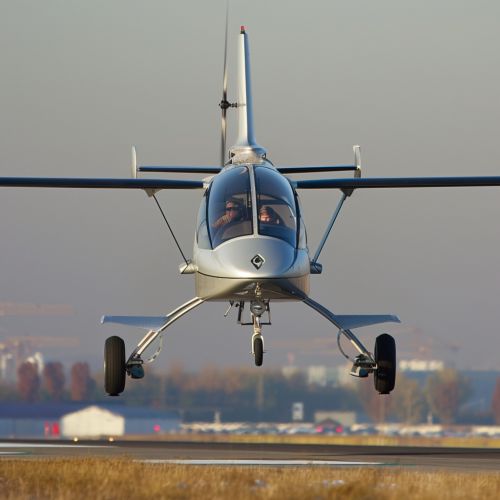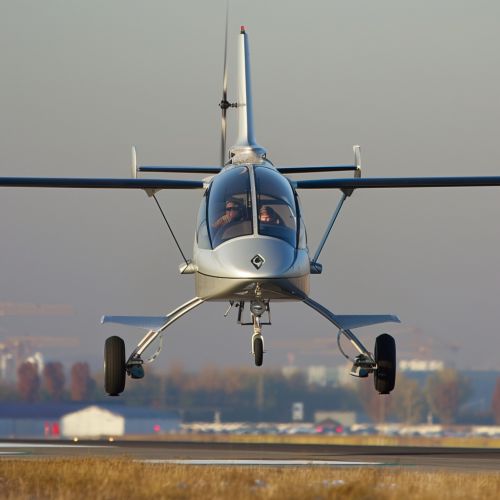Gyrocopters
Introduction
A gyrocopter, also known as an autogyro, gyroplane, or rotaplane, is a type of rotorcraft that uses an unpowered rotor in free autorotation to develop lift and an engine-powered propeller to provide thrust. Unlike helicopters, the rotor of a gyrocopter is not powered during flight. Instead, the rotor spins due to the aerodynamic forces resulting from the forward motion of the aircraft.
History
The gyrocopter was invented by the Spanish engineer Juan de la Cierva in 1923 to create a safer type of aircraft that could avoid stalling. The first successful flight of a gyrocopter took place on January 9, 1923, with the Cierva C.4. This invention marked a significant milestone in aviation history, leading to the development of various gyrocopter models over the decades.
Design and Components
Gyrocopters are characterized by their unique design, which includes several key components:
Rotor System
The rotor system of a gyrocopter consists of a large, unpowered rotor that spins freely in autorotation. The rotor blades are typically made of composite materials or aluminum to ensure strength and durability while minimizing weight. The rotor hub is designed to allow the blades to flap and feather, which helps to stabilize the aircraft during flight.
Propulsion
Gyrocopters use an engine-powered propeller for thrust. The engine is usually mounted in a pusher configuration, located behind the cockpit. Common engines used in gyrocopters include Rotax, Subaru, and Lycoming engines, known for their reliability and efficiency.
Airframe
The airframe of a gyrocopter is typically constructed from lightweight materials such as aluminum, steel, or composite materials. The design of the airframe varies depending on the model, but it generally includes a cockpit, landing gear, and control surfaces.
Control Systems
Gyrocopters use a combination of cyclic and collective controls to manage the rotor system. The cyclic control changes the pitch of the rotor blades cyclically to control the aircraft's roll and pitch. The collective control adjusts the pitch of all rotor blades simultaneously to manage lift.


Aerodynamics
The aerodynamics of gyrocopters are distinct from those of fixed-wing aircraft and helicopters. The unpowered rotor in autorotation generates lift through the relative airflow created by the forward motion of the aircraft. This process is known as autorotation, where the rotor blades are driven by aerodynamic forces rather than mechanical power.
Lift and Thrust
In a gyrocopter, lift is generated by the rotor blades as they spin in autorotation. The forward thrust is provided by the engine-powered propeller, which pushes the aircraft through the air. The combination of lift from the rotor and thrust from the propeller allows the gyrocopter to fly.
Stability and Control
Gyrocopters are inherently stable due to the design of their rotor system. The rotor blades' ability to flap and feather helps to dampen oscillations and maintain stability. Pilots control the aircraft using the cyclic and collective controls, as well as the rudder for yaw control.
Performance Characteristics
Gyrocopters offer several performance advantages, including short takeoff and landing (STOL) capabilities, excellent maneuverability, and the ability to fly at low speeds. These characteristics make gyrocopters suitable for various applications, including recreational flying, aerial photography, and agricultural operations.
Takeoff and Landing
Gyrocopters can take off and land in short distances due to their ability to generate lift at low speeds. During takeoff, the rotor is pre-spun to a high speed before the aircraft begins its takeoff roll. This allows the gyrocopter to achieve lift quickly and take off in a short distance.
Flight Envelope
The flight envelope of a gyrocopter includes a wide range of speeds and altitudes. Gyrocopters can fly at speeds ranging from 30 to 120 miles per hour (48 to 193 kilometers per hour) and can operate at altitudes up to 10,000 feet (3,048 meters).
Safety Considerations
Gyrocopters are considered to be relatively safe aircraft due to their inherent stability and ability to autorotate. However, like all aircraft, they require proper maintenance and pilot training to ensure safe operation.
Autorotation
One of the key safety features of gyrocopters is their ability to autorotate. In the event of an engine failure, the rotor will continue to spin and generate lift, allowing the pilot to perform a controlled descent and landing.
Training and Certification
Pilots of gyrocopters must undergo specialized training to become proficient in operating these unique aircraft. Training programs typically include both ground school and flight instruction, covering topics such as aerodynamics, aircraft systems, and emergency procedures. In many countries, pilots must obtain a specific license or certification to fly gyrocopters.
Applications
Gyrocopters are used in a variety of applications due to their versatility and performance characteristics. Some common uses include:
Recreational Flying
Many aviation enthusiasts enjoy flying gyrocopters for recreational purposes. The aircraft's maneuverability and STOL capabilities make it ideal for exploring remote areas and enjoying the thrill of flight.
Aerial Photography and Surveying
Gyrocopters are often used for aerial photography and surveying due to their ability to fly at low speeds and hover in place. This makes them well-suited for capturing detailed images and conducting surveys of land and infrastructure.
Agricultural Operations
In agriculture, gyrocopters are used for tasks such as crop dusting and aerial spraying. Their ability to fly at low altitudes and maneuver precisely makes them effective for applying fertilizers and pesticides to crops.
Future Developments
The field of gyrocopter technology continues to evolve, with ongoing research and development aimed at improving performance, safety, and efficiency. Some areas of focus include:
Advanced Materials
The use of advanced materials, such as carbon fiber composites, is being explored to reduce the weight of gyrocopters and enhance their structural integrity. These materials offer the potential for improved performance and fuel efficiency.
Electric Propulsion
Electric propulsion systems are being developed for gyrocopters, offering the potential for quieter and more environmentally friendly operation. These systems use electric motors and batteries to provide thrust, reducing the reliance on fossil fuels.
Autonomous Flight
Research is also being conducted into autonomous flight capabilities for gyrocopters. This technology could enable gyrocopters to operate without a pilot, opening up new possibilities for applications such as cargo transport and surveillance.
